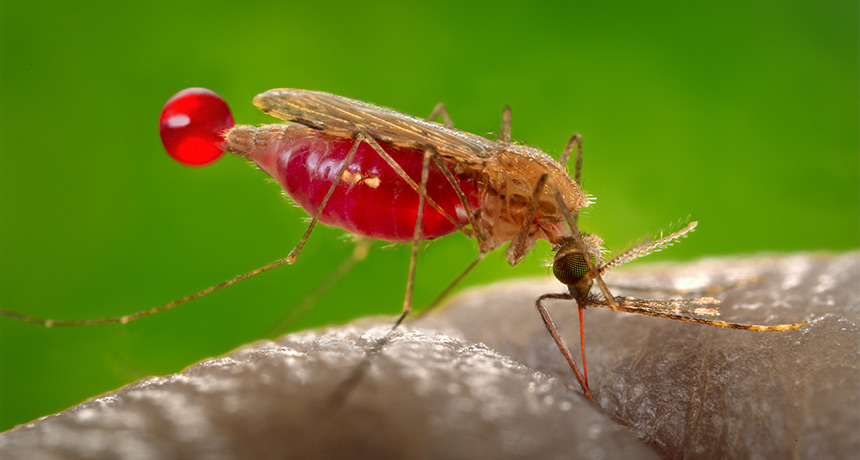
BITE BEFORE FLIGHT An unexpectedly high percentage of adult female mosquitoes were collected in air currents at least 40 meters above the ground in Mali.
Jim Gathany/CDC
VANCOUVER — Adult female mosquitoes could be surfing air currents high above the West African Sahel. This traffic, at least 40 meters up, might be troubling news for efforts to control malaria.
Traps attached to balloons flown over villages in Mali caught close to 3,000 mosquitoes at heights between 40 and 290 meters above the ground, where winds might blow the insects long distances. That sample, collected in multiple all-night sessions spaced over three years, was roughly 80 percent adult female, the mosquito life stage that can transmit malaria.
Some of the collected species are known to be capable of spreading malaria, said medical entomologist Tovi Lehmann in his preview of trap data November 14 at the 2018 joint annual meeting of three Canadian and American entomological societies. But Lehmann, of the National Institutes of Health in Rockville, Md., does not know yet whether the females were carrying the malaria parasite when they were caught by a balloon trap.
There’s been debate about what, if anything, such windborne mosquitoes might contribute to Africa’s patterns of entrenched malaria and high death tolls from the disease. That’s because “mosquitoes are generally thought to have short dispersal distances,” said veterinary entomologist Christopher Sanders of the Pirbright Institute in England who was not involved in the project.
So researchers tethered balloons with sticky net traps attached to the line for all-night sampling. To adjust for any insects snagged nearer the ground when either raising or reeling in a balloon, the scientists also sampled these pass-through zones. In the target upper region, traps picked up a total of about 460,000 individual insects of many kinds.
The team also found that the majority of female mosquitoes were already carrying eggs. That means that the insects must have had a blood meal for those eggs to develop. A malaria parasite or other pathogen might have hitchhiked along with that meal, but researchers have not finished that analysis yet.
Finding females carrying eggs was “a really novel result,” says Luigi Sedda of Lancaster University in England who works in medical geography but was not part of the balloon project. He speculates that these mosquito travelers might be a big problem in areas with an eradication or control program in place.
Among the trapped mosquitoes, researchers found representatives of at least three notorious mosquito genera. Out of 21 species of Anopheles known in the region, representatives of at least seven were bobbing along in air currents, Lehmann reported. That included An. coluzzii, a major malaria-spreading species in Africa.
The trap results might be relevant for diseases besides malaria. The Aedes mosquito genus includes carriers of West Nile virus and other worrisome pathogens. So far, results show that at least 12 species out of the 15 known in the area had gone airborne. So had at least 16 out of the 21 local Culex species, which include carriers of Rift Valley fever virus. Researchers confirmed the mosquito species’ identities with genetic bar codes.
It’s still unclear — for now, at least — whether the mosquitoes sampled were carrying malaria parasites or other pathogens. The balloon sampling team is figuring that out. It’s also unknown how much these surfing mosquitoes could contribute to disease spread. “We don’t know where and how long these mosquitoes have traveled,” Sedda says. “We don’t know their capacity to create new breeding sites, or if they get damaged in strong winds.”





